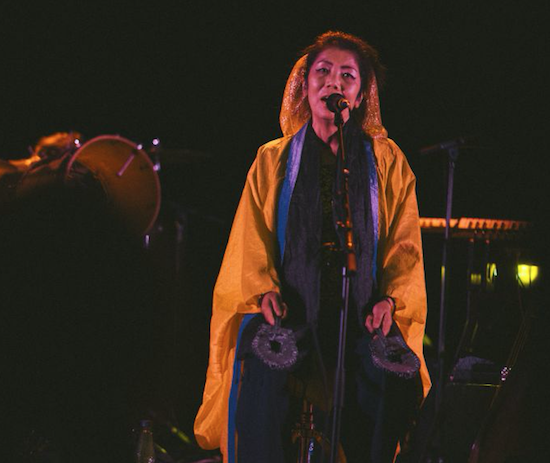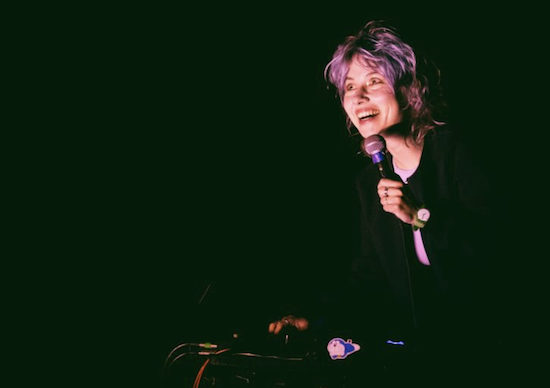As the evening sun dips below the harbour of Porto De Pescas De Rabo De Peixe, a pulsating crowd of about thirty mostly teenage hip hop performers are clustered at the side of a stage. All are rapping in Portuguese, mostly in the specific Florianopolitan Sāo Miguel dialect of the Azorean islands augmented by the universal sonic filter of AutoTune.
With names including Cafaia, Dusk, itzjotap, Joana Pacheco, kyasutā, Lil kyra, Madruga, NicTobu, NTK, Oestrela, Outsidah, Valério, Joya Black and Bensky, they are drawn from the various hip hop scenes around the Azorean Islands and put together with Sam The Kid, the influential Portuguese rapper who was one of the first to find success in the 1990s without switching to English. Shortly after the performance, the canteen by the stage blows up into a full-on rave, complete with a conga line to Brazilian pop and one of the DJs pouring local honey rum into punters’ open mouths.
As with the weather on the Azorean island’s notoriously changeable micro-climate, at São Miguel’s Tremor Festival you’re never exactly certain what you’re going to get next. An underground music and arts festival on the largest and most populous island in the Portuguese archipelago, Tremor has for eleven years now delivered lineups that feel tightly authored and thrillingly diverse. This year’s edition is heavily centred on unique collaborations, bringing performers from different disciplines together to the Ponta Delgada site.
Wherever you are at Tremor on the Wednesday, you just might be able to feel the vibrational hum of one particular performance. Marshstepper is the longstanding US transgressive noise project of JS Aurelius and Nick Nappe, who provide an eight-hour, full workday drone performance in collaboration with the local electronic collective Orquestra Modular Açoriana in a warehouse space on the edge of town. Entering the space somewhere around the sixth hour, their study in drone had cohered into something equal parts austere and ghostly as the musicians focused around trestle tables in the centre of the space.
Not to be outdone in intensity, that performance was matched by tQ mainstay and member of the soon-to-be-reformed Factory Floor, Nik Colk Void who was collaborating with Maotik, a French visual artist (AKA Matthew Le Sourd) who specialises in generative and controlled installations triggered by sound: this tonight means recurring geometric lines projected during moments of stasis, and then sudden and shocking descents into darkness when Void’s stately electronic gurgles erupt into bristling noise.

Nik Colk Void, during her performance
For something that is, on the surface, altogether more homely, the collaboration between guitarist Pedro Sousa and electronic musician Filipe Felizardo takes place on a stage decked out like a dimly lit suburban living room. The floor-standing tasseled lamps and tablecloths are, however, red herrings in a performance that is alchemical and brooding, led by Felizardo’s tremulous and distorted low-end electronics. In the performance’s quieter and most stirring moments, it finds an analogue in an excellent set by Cole Pulice. The experimental Oakland musician has won acclaim for albums released solo and with frequent collaborator Lynn Avery. Across a reverently received, feather-light set, Pulice crafts a sublime sound world built from looped finger-picked guitar and a sparse but meditative saxophone performance. The effect is utterly celestial.
Heaven aside, though, for more earthly concerns Tremor scores highly: though undoubtedly a larger festival than my first visit two years ago, there are always ample toilet facilities, the club area comes with easy to find water points, and all properly late-night functions take place in the centre of Ponta Delgada, meaning that any after-hours walks are generally well-lit and central. In terms of scheduling, don’t expect many performances until the festival gets into gear at around 7PM. During the day, though, there are walks, some talks and art installations across Ponta Delgada – this year’s ongoing nativity painting workshops, based on the practice that has been tradition on the island since the 19th century, and provides the inspiration for Tremor’s branding artwork, is wholesome and offered some unexpectedly psychedelic results.
Little was more psychedelic, however, than PoiL Ueda. A collaboration minted well ahead of Tremor, this is the union of Junko Ueda, a vocalist and satsuma-biwa player from Japan, and PoiL, the French band. Together, their self-titled debut on Durt Ex Doux was tQ’s 13th highest-ranked album of 2023. Their set conjures an extremely visceral and dramatic rendering of ancient lore from Buddhist texts to the 13th century Japanese epic of Heike-Monogatari. Those without a schooling in the classics need not worry: this is a scorching union of folk culture and avant-rock.

Junko Ueda, of PoiL Ueda, during her performance
The festival’s club bookings in 2024 are all held at the relatively new and excellent two room Portas Do Mar space, and further emphasise the festival’s themes of collaboration and creative invitation: take the appearance of Manchester’s All Hands On Deck collective, who run parties in the city linked to the Partisan club space chiefly for women, trans and non-binary people, or an excellent and expansive set from Palestinian heritage DJ Saya, whose gqom, kuduro and wide-ranging Arab experimental funk is accompanied by integrated visuals from artist Bárbara Paixão.
For this writer, though, the highlight – possibly of the festival – was Ugandan dancer and DJ Faisal Mostrixx. The Quietus first encountered Mostrixx as part of 2017’s Nyege Nyege Festival, and his grounding in that contemporary African scene is audible in his deeply compelling footwork and downtempo electronica intercut with samples and field recordings. It’s Mostrixx as a dancer, however, that provides a hugely dramatic experience. Mostrixx has been careful to rebuff Western fetishisation of Afrofuturism in the last half-decade and define it on his own terms, something he defines as being "a way to describe the meeting of the electronic and the tribal", and "about bringing the past into the now and then imagining how it could be expressed in the future". This plays out in the DJ largely in front of the rider clad in long robes and a futuristic, face-obscuring headset. A real highlight.
Over at the wood-panelled, gently modernist theatre Auditório Luís de Camões, the electronic producer Colleen says from the off that she is feeling emotional. Why? The Tremor show marks her 250th live performance, a landmark that is no small vindication for Cécile Schott’s practice, evidenced tonight in looping arpeggiations which form the core of gorgeous glacial Moog textures, which are glowing and strident. The set compliments another highlight, an outstanding performance by Russian maximalist pop performer Kate NV. To say that Kate NV takes silliness seriously can land as faint praise, but instead gets to the heart of the sheer craft in the defiantly escapist art that songwriter Ekaterina Shilonosova has crafted across four albums now. Aside from the 16-bit game music influences, day-glo primary colour optimism and sheer attack of her jagged and fragmented avant-pop, tonight it’s the movement that thrills: the singer vaults across the stage, grabs the air, at one point gets down on bended knees as though praying to her synthesiser. Bathed in blue light, it’s one of the most affirming and joyful sets of the weekend. More joy, too, was found in the northeastern Brazilian sounds of Lisbon four-piece Rastafogo at the stunning early 20th century Coliseum Micaelense.

Holy Tongue, during their performance
The collaboration that seemingly everyone in attendance said they were planning on attending, though, was Holy Tongue: the dub influenced side-hustle of the prolific percussion auteur Valentina Magaletti and electronic producer/ Trule Records boss Al Wootton, now expanded to include bassist and Magaletti’s Vanishing Twin bandmate Susumu Mukai. Their dub project comes firmly out of the post punk and hypnotic On-U Sound tradition, and tonight, Magaletti’s percussion is crisp and snappy, forming a skeleton core over which her bandmates’ sonics are expanded across the show. Watch the eye-contact between Mukai and Magaletti as they run the groove down from its most athletic to downcast, muggy and ambient, keeping it there until it rises again into an almost militaristic dub workout. Holy Tongue is increasingly one of Magaletti’s most bewitching projects.
In another fertile year for the Azorean festival, Tremor continues to deliver on its mission to provide challenging, exploratory and surprising art and music in a wide-ranging festival with only one real headline act: São Miguel itself.


